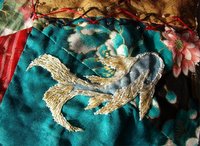そしてこのサイトですが、着物について非常に要領よくまとまっていて、私が曖昧な知識のまま書いているこのブログより余程、理解しやすいかもしれません。(とくに外国の人には)
A week ago, my friend Mireille from Belgium informed me she was reading a very interesting book titled "Geisha" by Liza Dalby and found her web site. I agree it was very good site especially for foreigners to understand about Kimono, even better than my blog. She experienced to be an actual geisha in Japan and studied about kimono. I have ordered her books to read too.

ベルギーにはミレーユともう一人、エリザベスという友人がいます。二人は月に一度会って、一緒に刺繍して一日を過ごすくらい親しい友人です。エリザベスの方が先生格です。二人とも日本が好きで、私は何冊か本を送っていますが、その中にこの本があります。実際は四冊シリーズです。
I have another Belgian friend Elizabeth, who is also a very close friend with Mireille. They have a stitching day a month regularly. Both love Japanese culture and have these Japanese embroidery patterns books I sent.

これはその本の中から、昨年のRRでエリザベスが刺した藤の花です。グループに送る前にまず私に見せてくれたのですが、エリザベスの刺繍技術が素晴らしいことはおわかりいただけるでしょう。でも彼女は藤の花の上にある図案が何なのかわからず、雲にしては近すぎるし、雪だと思うことにしたと教えてくれました。日本人なら松であることは自明なのですが、「藤に雪」なんて素敵な解釈だなあ、と私は感心しました。
Elizabeth picked up and embroidered a pattern of wisterias and sent me the photo before the CQI group. She wondered what were above wisterias and interpret snow. What a beautiful image of "Wisteria under snow"!! We Japanese can't imagine that because we know the shapes are pine leaves.

Can you see these shapes are the same as aboves? We have such kind of formula patterns.

この鯉もオリエンタルなモチーフなのに、エリザベスの刺繍ならではの魅力があります。彼女のフリッカーのアルバムが最近、ぐっと充実しました。是非是非、大勢の人に見て欲しいと思います。モチーフ刺繍も素晴らしいし、昨年作ったというクレージーのクリスマスボックスも本当に素敵です。
ミレーユもエリザベスも仕事が忙しくなってからCQIの活動にもあまり参加できなくなりました。でもその内絶対にまた、二人は戻ってきてくれることでしょう。こんなに刺繍もクレージーも好きなのですから。
This carp is also Elizabeth's motif for a oriental RR block. She is such a excellent embroiderer. You can see lots of beautiful motifs and CQ works in her flickr albumn. She has uploaded lots of photos recently.
Both Mireille and Elizabeth are too busy with their job to do group activities now. But I believe they would find time to come back to CQ again.
2 comments:
I am learning Japanese silk embroidery. The first design I stitched is called Hanayama (flower mountains?). One of the mountains has these stylizes pines so I 'know' that is what they are but I still think of them as clouds. To me the seam treatment you stitched on Rendi's "Narnia" block is more recognisable as pine but I am beginning to admire the stylistics designs like pine, flax, and kiko for their simplistic beauty.
Coral-seas
I know another American lady who is learning Japanese embroidery. I myself haven't done though I sometimes borrow the patterns.
My seam treatment is a single mass of pine leaves but the pattern is a shape of a branch. In Japan gardeners make each branches of a pine tree into that shapes. So it must be a familiar shape for us.
Post a Comment